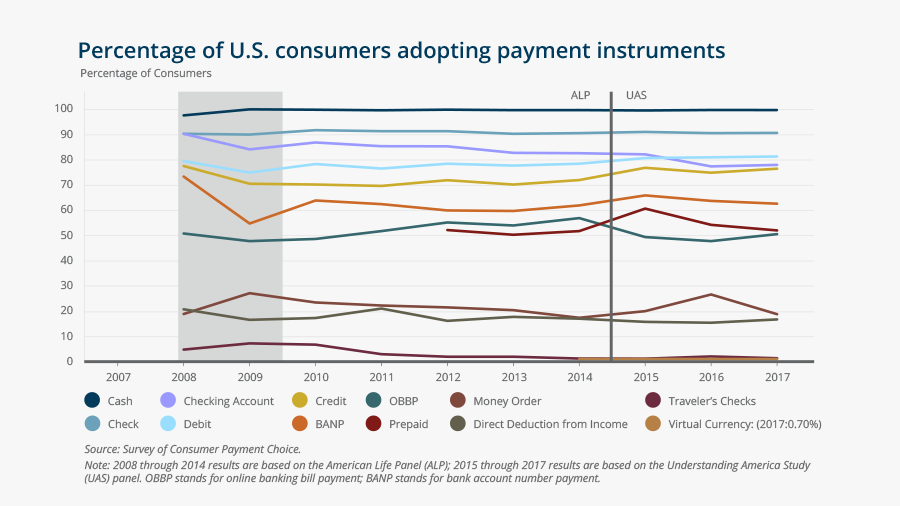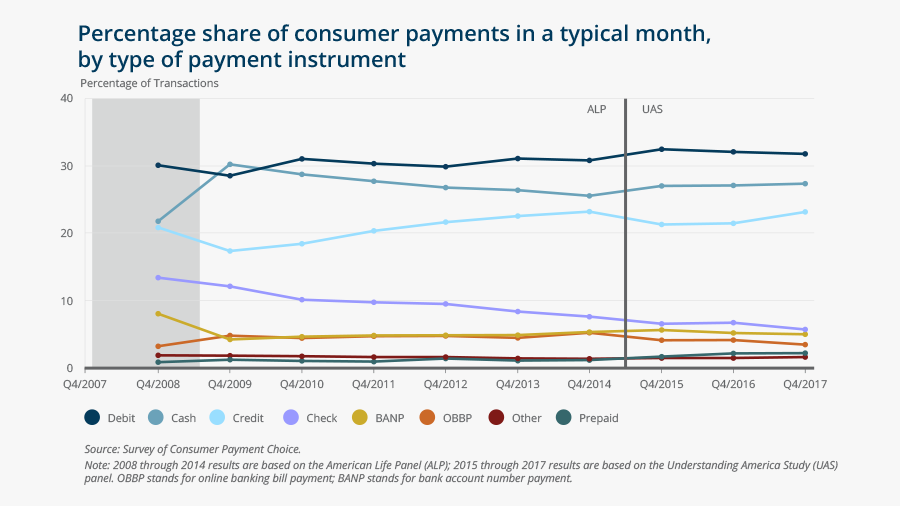- In each of the 10 years of the SCPC, all four major payment instruments—cash, debit cards, credit cards, and paper checks—were used by at least 70 percent of consumers in a typical month.
- In 2017, 12 percent of consumers reported that they did not pay with cash, even once, during the year. Between 2015 and 2017, the frequency of cash use remained unchanged.
- The share of paper check adopters has steadily declined over the past 10 years, and fewer than 80 percent of consumers who had paper checks on hand reported using them even once in 2017.
- In 2017, one-third of all consumers made a mobile payment, compared with just one-fourth in 2015.
- In each of the 10 years of the SCPC, more than 90 percent of U.S. consumers had a bank account. In 2017, 92.3 percent of U.S. consumers had a bank account and three-quarters of consumers used online banking; half used mobile banking.
- In 2017, 44.9 percent of consumers had a nonbank payment account; the most common was PayPal.
- At some point in 2017, 54.5 percent of credit card adopters carried an unpaid balance, compared with 59 percent in 2015.
- Among all payment instruments, cash was rated best for acquisition/setup and cost. It received the lowest rating for payment records and also scored poorly for security.
- In each of the last three years, one-quarter of consumers reported that they or someone they knew well had been a victim of identity theft during the previous 12 months.


More than half of U.S. consumers held six or more payment instruments in 2017, so they had many choices when making purchases or paying bills. Consumers continue to mostly use debit cards, cash, and credit cards for payments. The median number of credit cards for credit cardholders was three. Credit card use increased between 2015 and 2017, and consumers' assessment of credit cards was positive: They gave credit cards the highest ratings of all payment instruments for acceptance, convenience, payment records, and security.
The stability of payment trends over the last decade suggests that consumers have been slow to change their behavior despite the availability of new payment instruments that have emerged with changes in technology. However, the adoption of mobile apps for storing funds or making payments (such as Android Pay, Apple Pay, Samsung Pay) grew by about 25 percent in the last three years, from 40.4 percent of consumers in 2015 to 52.1 percent in 2017. Another statistically significant change involves online purchases: They accounted for an average of 6.9 percent of each consumer's monthly purchases in 2015 and rose to 8 percent in 2017.
Despite the introduction of new technology and new ways to make payments, the SCPC finds that consumer payment behavior has remained stable over the past decade. In the 10 years of the survey, debit cards, cash, and credit cards consistently have been the most popular payment instruments. In 2017, U.S. consumers age 18 and older made 70 payments per month on average. Debit cards accounted for 31.8 percent of those monthly payments, cash for 27.4 percent, and credit cards for 23.2 percent.
The SCPC continues to measure new ways to shop and pay and found that the increase in the number of purchases made online between 2015 and 2017 is statistically significant. In 2017, consumers on average made 5.6 online purchases per month, which accounted for 8 percent of all transactions and were up from 6.9 percent of all transactions in 2015. Use of mobile technologies continued to grow: in 2017, one-third of consumers made a mobile payment, compared with one-fourth in 2015.
Compared with the findings for 2015, a greater share of credit card adopters paid their balance in full at the end of the month in 2017: 45 percent in 2017 versus 41 percent in 2015.
Derived Variables with Raw Data
Raw Data
- Raw data files hosted at USC Dornsife Center for Economic and Social Research website
Results
Derived Variables with Raw Data
Raw Data
- Raw data files hosted at USC Dornsife Center for Economic and Social Research website
Results




